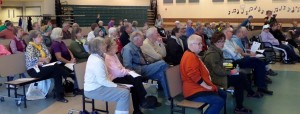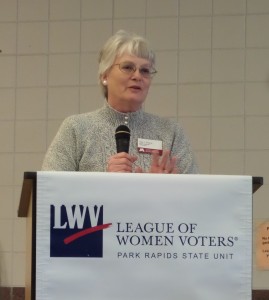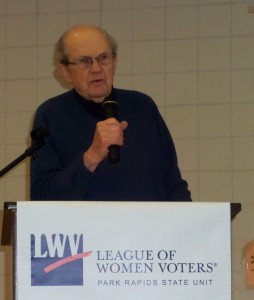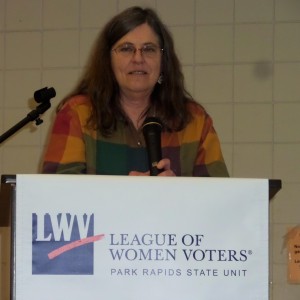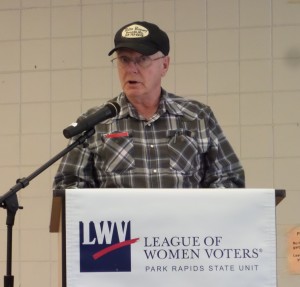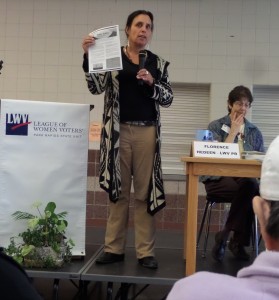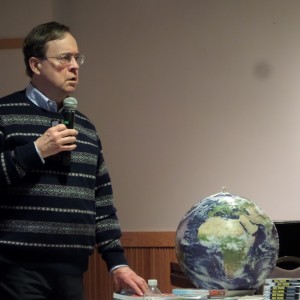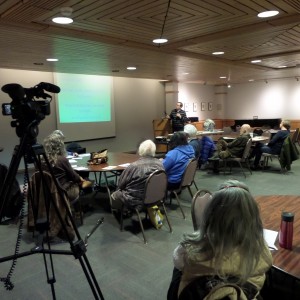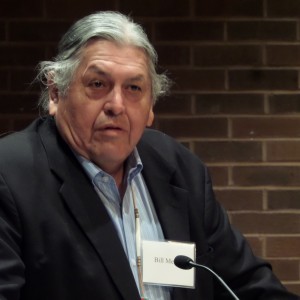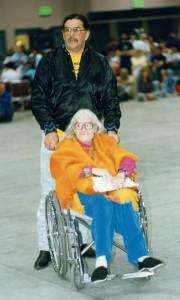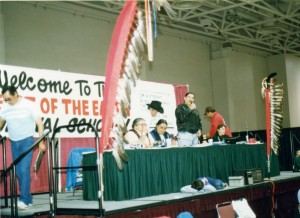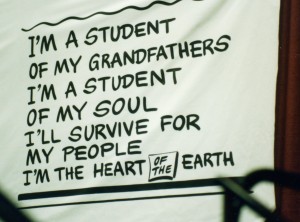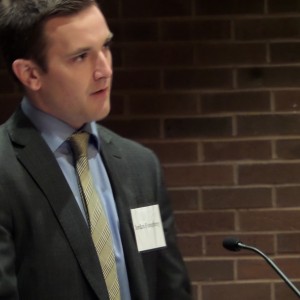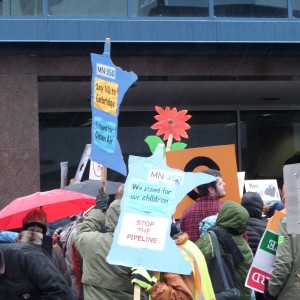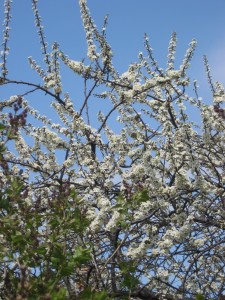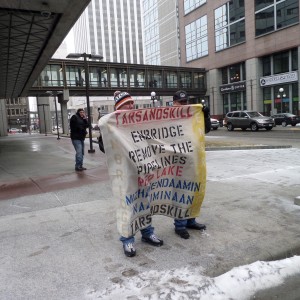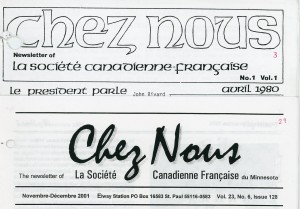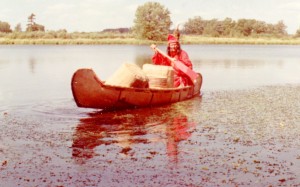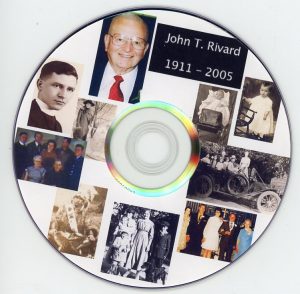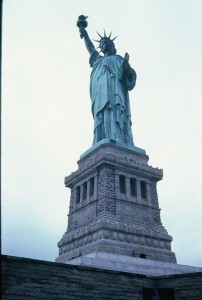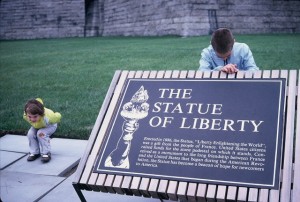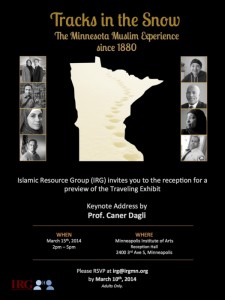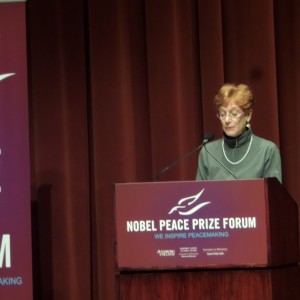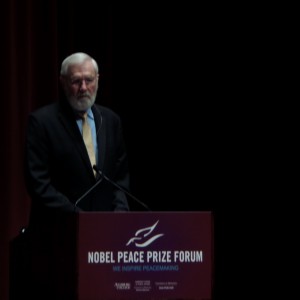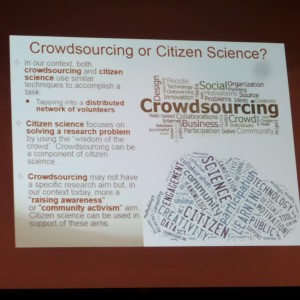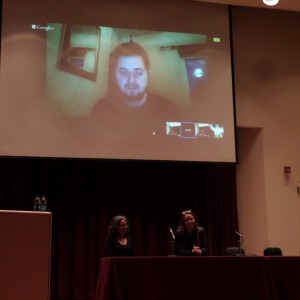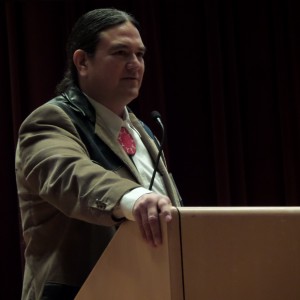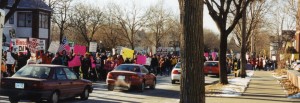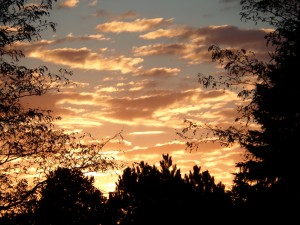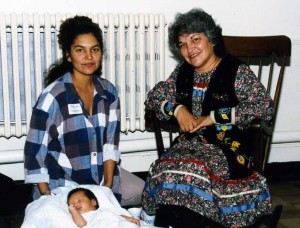Long-time great friend, Anne, has contributed her always valued perspective to this blog on several occasions. Her thoughts, below, arrived in my mailbox a couple of days ago and are presented with her permission. Her other posts, as well as other links referring to her or her work, can be found here. Thank you, Anne.
To everyone, all best wishes on November 27, and always. Personally, this day I’ll be going “over the river and through the woods” to visit Uncle Vince in North Dakota. Cathy will be here, with family nearby. As each year, we each are aware of persons, this day, for which this Thanksgiving and Christmas season will be a very difficult time, for an assortment of very legitimate reasons. Wherever you are on your personal journey, this season, all best wishes, and be mindful of others outside your personal sphere as well. Dick Bernard
(click to enlarge)
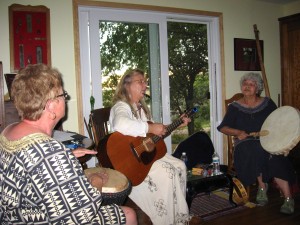
Anne Dunn, at right, with drum, August 31, 2013
The United American Indian National Day of Mourning and Parade of Truth originated in America’s hometown of Plymouth Rock, Massachusetts, 1970. Its purpose was to bring publicity to the continued misrepresentation of Native American Indians and the colonial experience. Relatives and friends came from the four directions to support the first Day of Mourning.
Anyone who has been there knows that it has grown over the years. The parade begins at the top of Cole’s Hill, near the statue of Massasoit, and ends at the waterfront. There is a harvest market, food festival, local vendors, a Wampanoag Pavilion for Native American history and lots more!
Some will raise their eyebrows and call this crass commercialism. But false pilgrim mythology annually raises millions of dollars off the backs of our slaughtered indigenous ancestors.
As was the case with Christopher Columbus, the pilgrims did not “discover” an empty land. It was populated by indigenous nations of children, women and men. Nor did they come seeking religious freedom. They were part of a commercial venture.
One of the first things they did upon coming ashore was to rob graves and steal the indigenous inhabitant’s winter food provisions.
The first thanksgiving day was proclaimed in 1637 by Gov. John Winthrop to celebrate the safe return of men who went to Mystic, Connecticut, to participate in the massacre of over 700 Pequot children, women and men.
The pilgrims/settlers/colonists had to be sanitized because the truth was too ugly to hold up as a symbol of heroic national glory. Nor was Plymouth the site of the first English settlement.
That would be Jamestown, Virginia, which was set up inside the territory of an Indian Confederacy led by chief Powhatan. When the English settlers went through their starving times, they resorted to cannibalism by digging up putrid corpses to feed upon.
In the winter of 1610, some of them ran off to join the Indians where they knew they would be fed. When summer came the governor of the colony sent a message to Powhatan asking for the return of the runaway men.
But as Benjamin Franklin would later declare, “No European who has tasted Savage Life can afterwards bear to live in our societies.”
The runaways did not want to return and soldiers were sent to take revenge on the Indians. They killed 15 or 16 Indians, burned their houses, cut down the corn, and took the ‘queen’ and her children. They later drowned the children and stabbed the ‘queen’ to death.
In 1623 the English were negotiating a treaty with tribes near the Potomac River, headed by Chiskiack. The English offered a toast symbolizing “eternal friendship”. Afterwards the chief, his family, advisors and 200 followers died of poison.
John Smith used Columbus as a role model for suppressing the Virginia Indians, 1624. “… you have 20 examples of how the Spaniards got the West Indies, and forced the treacherous and rebellious infidels to do all manner of drudgery work and slavery for them, themselves living like soldiers upon the fruits of their labor.”
The Disney version of history is colorful, romantic but false.
The only truth in the pilgrim myth is that the pitiful Europeans would not have survived the first several years of their occupation without the aid of the Wampanoag people. In return for their kindness the First Nation People got genocide, theft of land and slavery.
Abe Lincoln designated the fourth Thursday of November as a day of thanksgiving for the blessings of his ethnocentric god. Some claim the first thanksgiving day was observed in El Paso, Texas, 1598. Others point to the Virginia Colony celebration of 1619. George Washington set aside days for national thanksgiving in 1789.
But in 1970 Wamsutta Frank James was asked to speak at a state dinner celebrating the 350th anniversary of the pilgrim landing. The committee read his speech, found it unacceptable and asked him to modify it. But he refused to speak in praise of the white newcomers. Therefore, he was not allowed to make any statement at the event.
What terrible words did this Department of Commerce committee find so offensive that it required their censorship?
Here is what Wamsutta had prepared for presentation: “Today is a time of celebrating for you…but it is not a time of celebrating for me. It is with heavy heart that I look back upon what happened to my People… The Pilgrims had hardly explored the shores of Cape Cod before they had robbed the graves of my ancestors, and stolen their corn, wheat and beans… Massasoit, the great leader of the Wampanoag, knew these facts; yet he and his People welcomed and befriended the settlers…little knowing that…before 50 years were to pass, the Wampanoags…and other Indians living near the settlers would be killed by their guns or dead by their diseases that we caught from them… Although our way of life is almost gone and our language is almost extinct, we the Wampanoags still walk the land of Massachusetts… What has happened cannot be changed, but today we work toward a better America, a more Indian America where people and nature once again are important.”
Some historians take issue with Wamsutta’s including wheat in the list of stolen food. They say the Wampanoag did not cultivate wheat.
This effort to silence the voice of one man brought First Nation Peoples from throughout America to Plymouth where they mourned their forebears who had been sold into slavery, burned alive, massacred, cheated and mistreated since the arrival of the pilgrims.
They asked, how can we give thanks for the fact that on many reservations unemployment is often in excess of 50%; for lower life expectancies; high infant mortality; soaring suicide rates and 350 broken treaties?
Consider the racist stereotypes of indigenous people as perpetuated by the Washington Redskins, Cleveland Indians, Atlantic Braves, etc.
The annual protest has continued from that day to this. I have been told that the protest will stop when merchants of Plymouth are no longer making millions of dollars off the blood of our slaughtered ancestors; when we can act as a sovereign nation on our own land; when corporations stop polluting our Mother Earth; when racism is eradicated; when oppression of two-spirited people is a thing of the past; when homeless people have homes; when hungry children have food; when police brutality no longer exists and when all political prisoners are free.
On the 27th my family will celebrate our heritage by being thankful for another good and beautiful day. We will light a sacred fire and standing on a mound of cedar we will thank Creator for specific personal blessings and burn our prayer bundles. We will gather around the drum for a song of gratitude, pray, eat and offer a spirit dish to our ancestors who enrich our earth journey and wait for us to gather with them on the other side.
Anne M. Dunn is a long-time and wonderful friend, an Anishinabe-Ojibwe grandmother storyteller and published author. She makes her home in rural Deer River, MN, on the Leech Lake Reservation. She can be reached at twigfigsATyahooDOTcom. She has several previous posts at Outside the Walls. You can read them all here.



